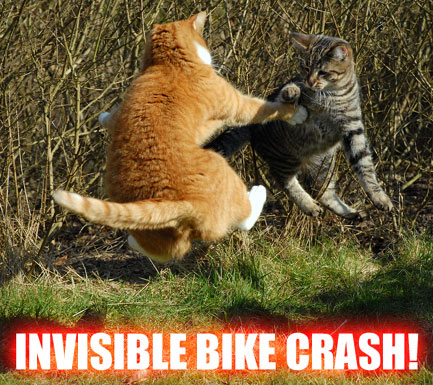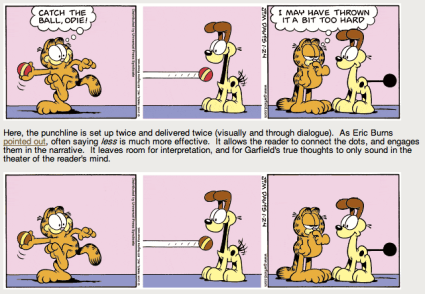Cats, Comics, and Closure
As it turns out, there’s more to say about kitty pidgin, and thanks to all of those who’ve emailed and commented with additional links.
First, a great example of prior art for the commercial use of lolcats is Twitter’s various errormessages. That’s the first place I’ve seen the grammar used in official (albeit informal) communications for a company.
More important is some of the additional understanding I’ve gained about why some forms of kitty pidgin are so delightful. Take, for example, invisible bike and its variations. Part of the delight of invisible item cat pictures is the element of surprise, the realization of where the missing item fits into the picture yields an “a-ha!” moment that’s much more satisfying than a more literal image would be. This isn’t surprising — a lot of humor relies on the element of surprise.

But there’s something more subtle going on here. If you’ve ever read Scott McCloud‘s Understanding Comics, you might be familiar with the concept of “closure”. There are many meanings for the word closure, of course, but in comics, it represents the crucial construct of allowing your reader or viewer to make the final connection with your media. This is wonderful for many reasons — it’s trusting the intelligence and creativity of your audience, knowing that they’ll make the mental connection in their minds. It’s also allowing for spontaneity and inspiration, instead of constraining the ideas (or humor) of an image to merely whatever the original author created. And most importantly, leaving space for your audience to interact with something as prosaic as a cat picture is just plain fun.
Closure has long been part of the vocabulary of comics.
“See that space between the panels? That’s what comics aficionados have named “the gutter!” And despite its unceremonious title, the gutter plays host to much of the magic and mystery that are at the very heart of comics…If visual iconography is the vocabulary of comics, closure is its grammar.”
Of course, other media make use of closure as well — in movies, our minds effortlessly connect each frame to those preceding and following it — but comics requires conscious (or semiconscious), high-level closure between every frame.
You need an example. Let’s go to the world’s worst humorous cat pictures: The Garfield comic strip.Fantagraphics has an astounding writeup of why Garfield sucks so bad, despite what your 9-year-old self thought back in the day.
I was impressed to find that Eric Burns and The Strip Doctor broke down what is most fundamentally flawed with Garfield’s humor. Redundancy. The problem with Garfield is redundancy. It’s redundant. The humor is. Redundant.
I could tell you about this, but that would contradict the premise. Take a look:

Invisible captions! LOL.